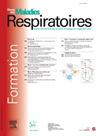Chronic and intermittent hypoxias lead to disrupted clock genes expression in mouse lung tissues: Implications for lung cell senescence
IF 0.5
4区 医学
Q4 RESPIRATORY SYSTEM
引用次数: 0
Abstract
Introduction
Obstructive sleep apnoea syndrome (OSAS) and chronic obstructive pulmonary disease (COPD) are common syndromes that lead either to intermittent or chronic hypoxia. We previously demonstrated that OSAS and COPD were associated with telomere shortening and increased cell senescence. Furthermore, we showed that pulmonary hypertension (PH) driven by chronic hypoxia in mice is associated with an accumulation of senescent cells in the lung. The cyclin-dependent kinase inhibitor p21, the main effector of p53, is activated in response to DNA damage and telomere dysfunction but is down-regulated by certain clock genes. Sleep abnormalities and hypoxia also disrupt endogenous circadian clock genes, more specifically Rev-Erbα, a central transcriptional repressor of the molecular clock that downregulates p21 expression.
Methods
We investigated mice exposed to chronic intermittent hypoxia (CIH) and to chronic hypoxia (Hx) in comparison to normoxic mice. Mice exposed to CIH were subjected to repeated cycles of 90 sec hypoxia-reoxygenation (21–5% O2), 8 hours a day for one to 21 days, biological analyses were performed on the day after CIH discontinuation. Hx mice were exposed to chronic hypoxia (10% O2) during 3 weeks. Similar protocols were performed in Rev-Erbα KO mice.
Results
In normoxic mice, rhythmicity of the canonical clock genes Rev-Erbα, Rev-Erbβ, and Bmal-1 was associated with rhythmicity of lung p21, with opposite variations in Rev-Erbα and p21. Compared to normoxia, CIH for 1.2, 7, or 21 days increased Rev-Erbα at ZT 2-4 (morning) and downregulated p21; these effects persisted beyond 48 hours after CIH cessation. Bulk RNA sequencing performed 3 weeks after CIH confirmed dysregulation of the circadian clock and clock-controlled genes (Dbp, Rev-Erbα, Hlf) and showed increases in several collagen transcripts. Senescence markers including p16 and SASP components were unaffected by CIH exposure. Similar findings were observed in aged (18-month-old) mice. Rev-Erbα KO mice compared to WT mice exhibited an increase in lung p16 positive nuclei. Consistent with this, cultured primary lung fibroblasts from Rev-Erbα KO mice compared to WT mice exhibited premature senescence-as assessed by increased β-galactosidase positive cells and decreased cell growth. Conversely to WT mice exposed to CIH, WT mice exposed to Hx exhibited a downregulation of Rev-Erbα together with increased p21 expression. Moreover, Rev-Erbα KO mice exposed to Hx were partially protected against hypoxia-induced PH. Studies are underway to assess PH in CIH mice.
Conclusion
Clock genes, namely Rev-Erbα, plays an important role in the response to CIH and Hx by affecting cell senescence with, consequently, a reduction of lung cell proliferation and protection against PH.
求助全文
约1分钟内获得全文
求助全文
来源期刊

Revue des maladies respiratoires
医学-呼吸系统
CiteScore
1.10
自引率
16.70%
发文量
168
审稿时长
4-8 weeks
期刊介绍:
La Revue des Maladies Respiratoires est l''organe officiel d''expression scientifique de la Société de Pneumologie de Langue Française (SPLF). Il s''agit d''un média professionnel francophone, à vocation internationale et accessible ici.
La Revue des Maladies Respiratoires est un outil de formation professionnelle post-universitaire pour l''ensemble de la communauté pneumologique francophone. Elle publie sur son site différentes variétés d''articles scientifiques concernant la Pneumologie :
- Editoriaux,
- Articles originaux,
- Revues générales,
- Articles de synthèses,
- Recommandations d''experts et textes de consensus,
- Séries thématiques,
- Cas cliniques,
- Articles « images et diagnostics »,
- Fiches techniques,
- Lettres à la rédaction.
 求助内容:
求助内容: 应助结果提醒方式:
应助结果提醒方式:


